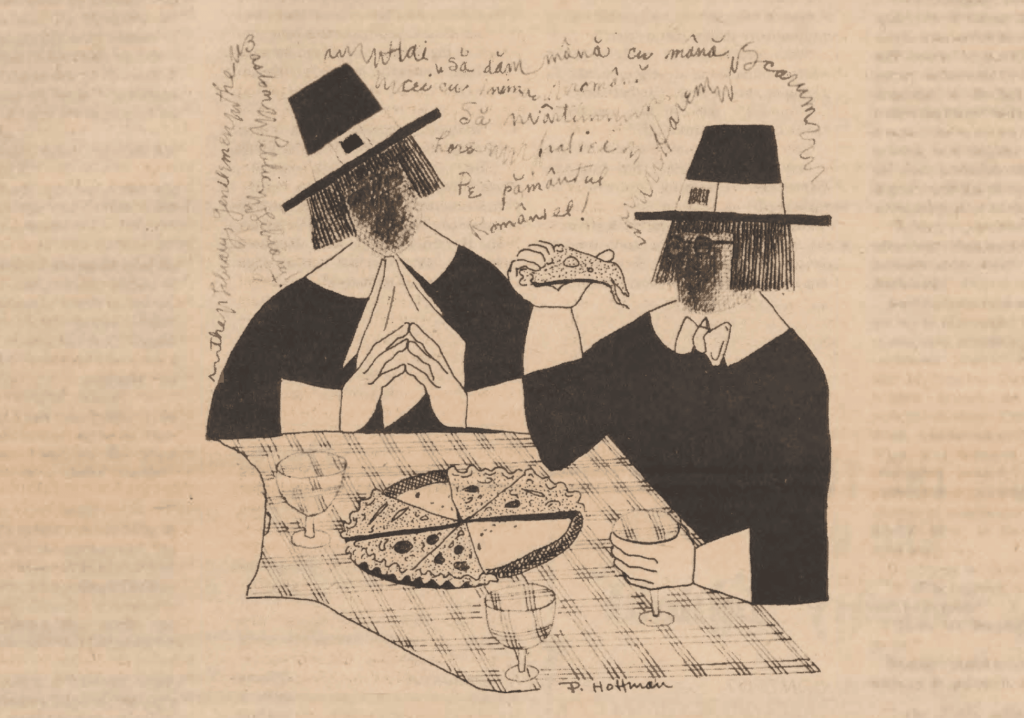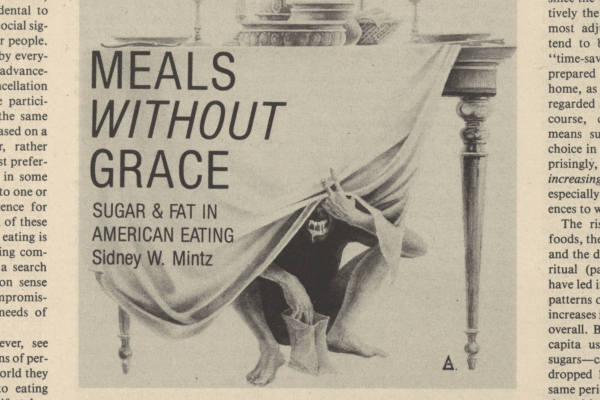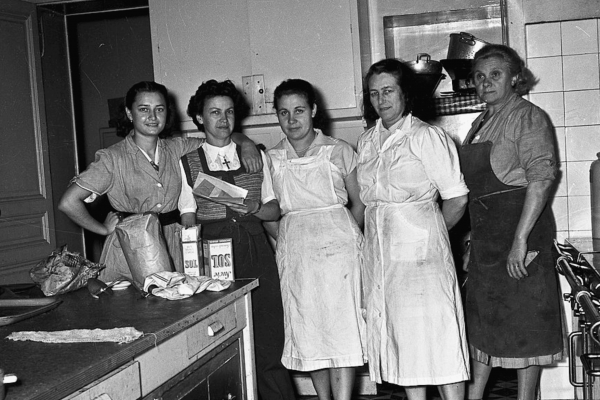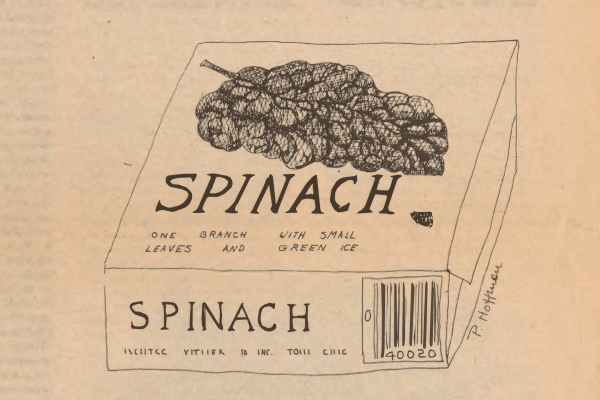American Food: The Gastronomic Story
Evan Jones
How did we feed ourselves in those early days, after stepping off Plymouth Rock and into the wilds of primeval Massachusetts? What was it like at the dinner table in great-great-grandmother’s time if she lived in Virginia or Wisconsin, New Orleans, Kansas City, or wherever she found herself? Where did chili come into the picture? What about oysters? How about corn on the cob? I, for one, knew very little about the history of American culinary origins and traditions until I plunged into Evan Jones’ book, American Food, and I’ve been on a corn extravaganza ever since. I had never known, for instance, that the early settlers appointed some of their women to live side by side with the Indians and learn their ways of growing com, harvesting it, roasting fresh-picked ears, and eating it in their fingers—moving the cobs “across their hungry mouths like harmonicas.” In fact, it was corn and codfish that kept those pilgrims going; it was corn that fed the two American continents, actually; and corn culture spread to the rest of the world within a generation of its discovery in the Americas.
American Food is, for me at least, the kind of book that sends one off on tangents of discovery and experiment. And after my corn orgy, which has so far included fresh corn pudding, corn crepes, corn gnocchi, and a wonderfully tender corn scrapple concocted with homemade sausage meat, I might try Mr. Jones’ chili suggestions, since I know nothing at all about that phase of our national heritage.
Now to get back from tangential meanderings to the book in hand, it’s a big one—8 by 11 inches across, 1½ inches thick—handsomely encased in a nostalgic jacket depicting, in full color, an old-time Fourth of July picnic. A narrative history of American gastronomy comprises the first third of the book—starting out with the Puritans and with plantation living and going on to early French influences, then the Spanish and the German and the Dutch contributions, and an unusually interesting section on soul cooking and the contribution of Black cuisine to the whole fabric of our American culinary background. Thus Mr. Jones proceeds through the decades, including a fascinating tour of the early health-food buffs in Battle Creek and ending with life as it is today for American stomachs.
It is a lively and interesting text. my only criticism being, however, that I wish Evan Jones had gone more into the revival of American interest in good cooking —which began in the early 1930’s, and included such figures as the late Jeanne Owen, Dione Lucas, and the fine contributions by June Platt, Mildred Knopf, and others who kept the flame alive during the lean years of suddenly servantless households and the appearance of those early frozen foods and TV dinners. (But that, perhaps, is a period James Beard must some day explore for us, since he was in at the beginning and remains one of the liveliest of its surviving figures in our present gastronomical scene.)
Formal recipes take up the rest of the book, some 500 dishes in all, nicely spaced on the large pages and very American indeed, which is a treat to me, satiated as I am on the European fleshpots. These recipes bring back my California youth when we ate very well, with my grandmother’s Illinois fresh raised doughnuts and crullers, my mother’s western Massachusetts Sunday codfish balls and egg sauce, and her special Thursday evening Welsh rarebit, plus the especially lush fruits and vegetables of the southern California countryside. It was simple, uncomplicated cooking that I grew up with, and that is what the recipes reflect here. Evan Jones’ wife Judith has collaborated with him in this part of the book since they both cook, and they cook together. And a most reassuring aspect of the dishes presented is that I, personally, know they all will work because I have dined numerous times with the Joneses. In fact, I must now reveal it, Judith Jones is my editor at Alfred A. Knopf, Inc., and although I am inclined favorably to any effort in which she and her husband are involved, I know their serious and delighted concern with cooking, their honesty, and their exceptionally good food.
They have made a delightful collection of recipes, some ancient, some contemporary, and many inventions and combinations of their own. I like their uncomplicated cocktail tidbits, such as their avocado spreads, chili and cheese dips, prosciutto and crab rolls. Their Michigan blinis of buckwheat pancakes, Wisconsin caviar, and sour cream are a delight, as is Aunt Rose’s cheese and pimiento custard spread. They’ve evolved a fine selection of simple-to-do but elegant first courses like crab soufflés in scallop shells, scalloped shrimps, and whitefish appetizers—all are easy but they result in the sophisticated presentation one longs for when company is coming. As for the muffin, hot-bread, and pancake section, I am not qualified at all to judge, being too concerned with the battle of the bulge; just a glance, however, revealed far too much that is appealing.
Going on through the recipes, it is obvious the Joneses love soups, for their roster includes artichoke, avocado, and barley soups, a cold tomato soup with cantaloupe, a chicken soup with corn and homemade noodles, eel soup, onion and hamburger soup, sweet potato soup, and a jellied watercress consommé. The main course section includes numerous ideas for the less expensive meat cuts with pot roasts, stews, hamburgers, beef shanks, and ribs. There are ham hocks and greens with southern pot liquor, chitlins, three fine recipes for rabbit, liver recipes, tripe croquettes, a capon stuffed with mashed potatoes, and a delicious oyster stuffing for chicken breasts (which the Joneses did for us here in Cambridge, to great acclaim by all who tasted them). Recipe directions are short and to the point, some belying more complications—like Lobster Americaine—than others: in Alfred Lunt’s famous pot roast the meat is simply browned, then set to cook with vinegar, maple syrup, onions, spices, and anchovies – the directions literally take up only five lines.
I shan’t go on. except to mention some homey favorites like a special family recipe for brownies and various of their own favorites—like Louise Sheldon’s fudge bars and sesame cookies (Charleston benne-seed wafers) which we sampled and found better than any we had in the originating region itself. I like such uncomplicated desserts as “Phillis’s Orange Jelly,” that, again, reminds me of my youth and is simply fresh orange juice, sugar, lemon, and gelatin poured over a mold lined with peeled, seedless grapes. Many other typical American desserts are there, too, like sweet-potato pie, lemon meringue and Boston cream pie, plus unusual local recipes like a salt pork and apple pie, and a persimmon-buttermilk pudding.
In sum, I find this is a most appealing book. Evan Jones is a historian who has specialized in Americana; he is also a cook and traveling reporter whose work has appeared in national magazines such as Gourmet, Travel and Leisure, and others. Thus he writes both of history and of gastronomy with authority and grace. I like it, then, both as a source book and as entertainment, and, of course, as a cookbook. In addition, I have learned so much from it about our own country, and that, in this year of the Bicentennial, is what we are all supposed to do.
(P.S: Although I usually hand out my own cookbooks as wedding presents, I may well break with tradition and send American Food to several happy couples during this nuptial month of June. It would look well indeed among the array of bridal gifts, and the recipes are of a sort that budding cooks should be able to tackle without qualms and with a certain assurance of success—and that, too, is what’s needed during those first months of marriage.)








